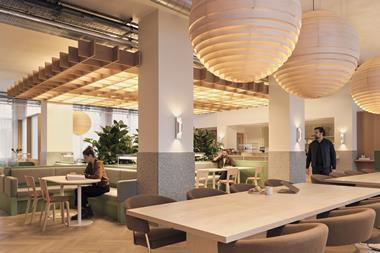Greenery has long been a decorative feature of real estate schemes but it can play a more functional role

Biophilia has been a buzzword in the business of real estate for some years now, and with good reason. According to the UK Green Building Council, “biophilic design features can have positive impacts on mental and physical health”, as well as creating a more productive, less stressful working environment.
Urban vertical farming businesses such as ours can contribute significantly in terms of the human instinct to connect with nature. While other forms of biophilia, from green walls to artworks depicting nature, can contribute to wellbeing and sustainability, they are more decorative elements.
Urban farming creates a more functional form of biophilia. In simple terms, you can eat the greenery that you see. But beyond that, there are multi-layered benefits to biophilia that go far beyond simply ‘greening the office’.
Urban farms can solve the practical issues of wasted space within an office environment, bringing a blank wall, a stairwell or a dark corner to life.
But more than that, it is about engendering a sense of community and belonging, and helping to reconnect teams. This is especially pertinent with the post-pandemic rise of hybrid working.
Urban farming and other forms of biophilia can be used as an active tool for collaboration and engagement with people in a building. We invite people to join us for the harvest. It is not a passive part of the workplace; we actively encourage people to get involved, to take away food grown in the office and pick up tips for growing plants at home.
This can be a targeted employee benefit and differentiator from what competitor employers are doing, which, during the Great Resignation, is a highly valuable benefit, keeping employees motivated and loyal.
Biophilia can stimulate conversations around corporate responsibility and sustainability goals. Learning about plants in the office encourages bigger-picture thinking: employees better understand a business’s ESG goals, from achieving net zero to decarbonising supply chains and looking at waste and landfill policies.
Climate commitments
Urban farms can be a shop window for an organisation’s ESG policy. Biophilia is a physical reality that sends a clearer message about a company’s climate change commitments than the printed pages of a policy document or an intranet portal.
We are still at a relatively early stage of our form of biophilia: urban farming does not yet fit with what is recognised in terms of building, wellbeing and sustainability standards. The WELL Building Standard does not yet recognise edible food production as part of its certification around office greenery. And the latest iteration of planning guidelines focuses solely on exterior planting. Food production inside has not been fully recognised yet.
But there are practical reasons for focusing on indoor urban farming. Outdoors, you can expect two to three harvests a year, whereas indoors, that figure rises to 17 or 18 harvests.
We are working with many layers of the real estate sector – from developers and asset managers to facility managers and front-of-house staff, as well as directly with occupiers and large corporates – to fully realise the biophilic benefits of the future.
Our next step will be working more closely with developers to embed the biophilic benefits of urban farming within significant real estate projects as a fundamental part of the schemes’ amenities.
We see the potential for scaling up community-led urban farms in London, further afield within the M25 and eventually beyond.
Hamish Grant is chief growth officer of Square Mile Farms






























No comments yet